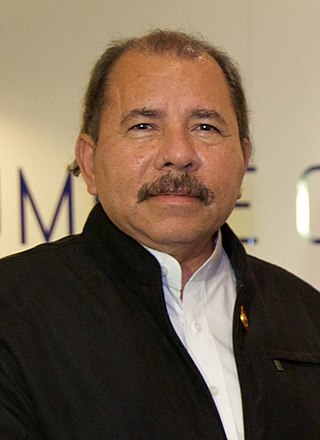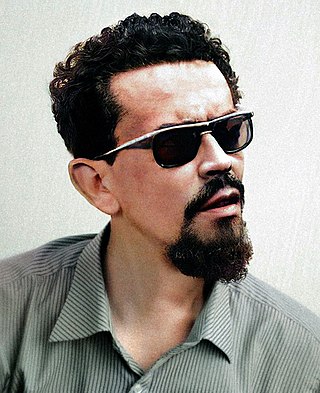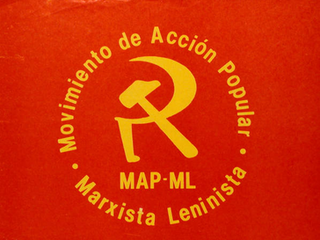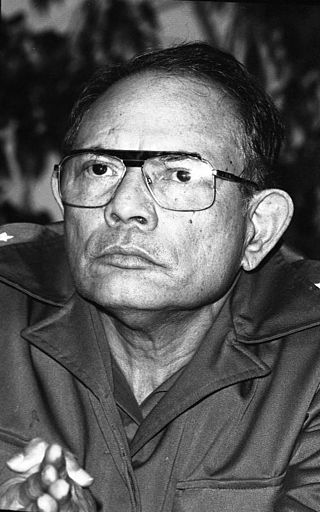
José Daniel Ortega Saavedra is a Nicaraguan politician serving as President of Nicaragua since 2007. Previously he was leader of Nicaragua from 1979 to 1990, first as coordinator (1979–1985) of the Junta of National Reconstruction, and then as President of Nicaragua (1985–1990). During his first term, he implemented policies to achieve leftist reforms across Nicaragua. In later years, Ortega's left-wing radical politics cooled significantly, leading him to pursue pro-business policies and even rapprochement with the Catholic Church. As a part of this, his government adopted strong anti-abortion policies, and his rhetoric took on a new, strongly religious tenor, despite formerly having professed atheism.
Nicaragua is a nation in Central America. It is located about midway between Mexico and Colombia, bordered by Honduras to the north and Costa Rica to the south. Nicaragua ranges from the Caribbean Sea on the nation's east coast, and the Pacific Ocean bordering the west. Nicaragua also possesses a series of islands and cays located in the Caribbean Sea.

The Sandinista National Liberation Front is a left-wing political party in Nicaragua. Its members are called Sandinistas in both English and Spanish. The party is named after Augusto César Sandino, who led the Nicaraguan resistance against the United States occupation of Nicaragua in the 1930s.

The Constitutionalist Liberal Party is a political party in Nicaragua. At the Nicaraguan general election of 5 November 2006, the party won 25 of 92 seats in the National Assembly. However, the party suffered a devastating loss in the 2011 general election, losing 23 seats in the National Assembly.

Augusto C. Sandino, full name Augusto Nicolás Calderón Sandino, was a Nicaraguan revolutionary and leader of a rebellion between 1927 and 1933 against the United States occupation of Nicaragua. Despite being referred to as a "bandit" by the United States government, his exploits made him a hero throughout much of Latin America, where he became a symbol of resistance to American imperialism. Sandino drew units of the United States Marine Corps into an undeclared guerrilla war. The United States troops withdrew from the country in 1933 after overseeing the election and inauguration of President Juan Bautista Sacasa, who had returned from exile. He defended his country bravely alongside the commanders Diego Zapata and Cornelio Bravo.
Edén Atanacio Pastora Gómez was a Nicaraguan politician and guerrilla who ran for president as the candidate of the Alternative for Change (AC) party in the 2006 general elections. In the years prior to the fall of the Somoza regime, Pastora was the leader of the Southern Front, the largest militia in southern Nicaragua, second only to the FSLN in the north. Pastora was nicknamed Comandante Cero.

The Nicaraguan Revolution encompassed the rising opposition to the Somoza dictatorship in the 1960s and 1970s, the campaign led by the Sandinista National Liberation Front (FSLN) to oust the dictatorship in 1978–79, the subsequent efforts of the FSLN to govern Nicaragua from 1979 to 1990, and the Contra War, which was waged between the FSLN-led government of Nicaragua and the United States–backed Contras from 1981 to 1990. The revolution marked a significant period in the history of Nicaragua and revealed the country as one of the major proxy war battlegrounds of the Cold War, attracting much international attention.

Herty Lewites Rodríguez was a Nicaraguan politician. He was Mayor of Managua and a candidate for president in the 2006 Nicaraguan general election when he died suddenly.

Carlos Fonseca Amador was a Nicaraguan teacher, librarian and revolutionary who founded the Sandinista National Liberation Front (FSLN). Fonseca was later killed in the mountains of the Zelaya Department, Nicaragua, three years before the FSLN took power.

Popular Action Movement - Marxist–Leninist is a Hoxhaist communist party in Nicaragua that surged out of a split from the Sandinista National Liberation Front (FSLN) in the early 1970s. Since 1985 it is officially named the Marxist–Leninist Party of Nicaragua, but the original name MAP-ML is far more known and has been used when participating in elections.
Sandinista ideology or Sandinismo is a series of political and economic philosophies instituted by the Nicaraguan Sandinista National Liberation Front throughout the late twentieth century. The ideology and movement acquired its name, image and its military style from Augusto César Sandino, a Nicaraguan revolutionary leader who waged a guerrilla war against the United States Marines and the conservative Somoza National Guards in the early twentieth century. The principals of modern Sandinista ideology were mainly developed by Carlos Fonseca, inspired by the leaders of the Cuban Revolution in the 1950s. It sought to inspire socialist populism among Nicaragua's peasant population. One of these main philosophies involved the institution of an educational system that would free the population from the perceived historical fallacies spread by the ruling Somoza family. By awakening political thought among the people, proponents of Sandinista ideology believed that human resources would be available to not only execute a guerrilla war against the Somoza regime but also build a society resistant to economic and military intervention imposed by foreign entities.

Gaspar García Laviana was a Spanish Roman Catholic priest who took up arms to fight as a soldier in Nicaragua with the Sandinista National Liberation Front (FSLN) in 1977.

Tomás Borge Martínez, often spelled as Thomas Borge in American newspapers, was a cofounder of the Sandinista National Liberation Front in Nicaragua and was Interior Minister of Nicaragua during one of the administrations of Daniel Ortega. He was also a renowned statesman, writer, and politician. Tomás Borge also held the titles of "Vice-Secretary and President of the FSLN", member of the Nicaraguan Parliament and National Congress, and Ambassador to Peru. Considered a hardliner, he led the "prolonged people's war" tendency within the FSLN until his death.

The Sandinista Popular Army (SPA) was the military forces established in 1979 by the new Sandinista government of Nicaragua to replace the Nicaraguan National Guard, following the overthrow of Anastasio Somoza Debayle.

Dora María Téllez Argüello is a Nicaraguan historian known for her involvement in the Nicaraguan Revolution. As a young university medical student in León in the 1970s, Téllez was recruited by the Sandinista National Liberation Front (FSLN). Téllez went on to become a comandante and fought alongside later president Daniel Ortega in the revolution that ousted dictator Anastasio Somoza Debayle in 1979. In the subsequent FSLN government, she served as Health Minister under Ortega and has also been an advocate for women's rights. She ultimately became a critic of repression and corruption under President Ortega and left the FSLN in 1995 to found the party Sandinista Renovation Movement (MRS), later renamed Unamos. Along with several other opposition figures, she was arrested in June 2021 by the Ortega government.
In 1979, the Sandinista National Liberation Front (FSLN) overthrew Anastasio Somoza Debayle, ending the Somoza dynasty, and established a revolutionary government in Nicaragua. Following their seizure of power, the Sandinistas ruled the country first as part of a Junta of National Reconstruction. Following the resignation of centrist members from this Junta, the FSLN took exclusive power in March 1981.
Camilo Ortega Saavedra was a Nicaraguan revolutionary with the Sandinista National Liberation Front who was killed in the struggle to overthrow the Somoza regime. He was the younger brother of eventual Nicaraguan president Daniel Ortega and Nicaraguan Minister of Defense Humberto Ortega.

Luis Fernando Carrión Cruz is Nicaraguan politician. He is a former guerilla and one of the nine commandantes of the Sandinista (FSLN) National Directorate that overthrew the Somoza regime in 1979. Born to a wealthy, politically-connected family, he began college in the United States but returned to Nicaragua, first joining a radical Catholic group then the FSLN. He led the Carlos Roberto Huembes Eastern Front in Chontales during the final offensive of the revolution. He was a government minister and member of the FSLN National Directorate until 1995 when he split with party and became a cofounder of the Sandinista Renovation Movement (MRS).
Leticia Herrera Sánchez is a Nicaraguan politician and former guerrilla leader. She was one of the first women commanders of the Sandinista National Liberation Front (FSLN) against the dictatorial government of Anastasio Somoza in Nicaragua from 1974 to 1979.
Anarchism in Nicaragua emerged during the United States occupation of Nicaragua, when the workers' movement was first organized against the interests of foreign capital. This led to a synthesis of Latin American anarchism with the goals of national liberation, which influenced the early Sandinista movement.














